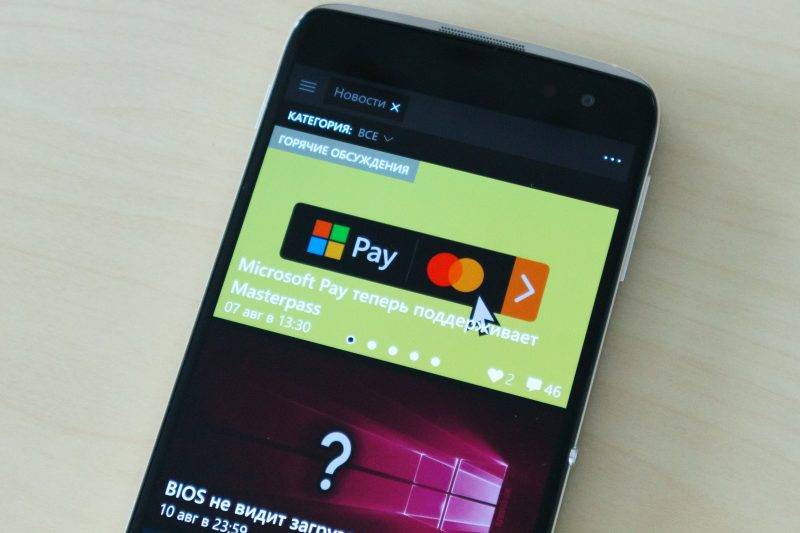
Alcatel Idol 4S, наряду с HP Elite X3, является последним аппаратом на операционной системе Windows Mobile 10, который совсем недавно можно было купить новым в магазине. Он интересен не только своими характеристиками и внешним видом, но также ценой, которая была очень привлекательной в конце продаж.
Для начала напомню его основные характеристики:
- 153.90 x 75.40 x 6.99 мм, 152 грамма.
- Дисплей 5.5″ 1920×1080, AMOLED, стекло Dragontrail (японский аналог Gorilla Glass).
- Процессор Qualcomm Snapdragon 820 MSM8996, 2200МГц, видеоадаптер Adreno 530.
- 64 Гб встроенной памяти, 4 Гб ОЗУ, возможность установки карты памяти MicroSD объёмом до 128 Гб.
- Основная камера – 21 Мп f/2.2 с двойной вспышкой, фронтальная – 8 Мп со вспышкой.
- Два стереодинамика мощностью 1,2 Вт.
- Аккумулятор на 3 000 мАч, заявленное время работы в режиме ожидания – 420 часов, в режиме разговора – 20 часов.
- Сканер отпечатка пальца
Последняя цена аппарата в американском Microsoft Store составляла $99.99 либо $169 за версию с VR-очками в комплекте.
Комплектация и первый взгляд на телефон, аппаратное оснащение
Комплектация скудная: телефон, зарядное устройство со съемным USB-проводом, ключик для открытия лотка сим-карты / карты памяти, да инструкция. Зарядное устройство поддерживает Quick Charge 2.0, но для его использования вне США нужно будет докупить переходник – вилка там плоская.
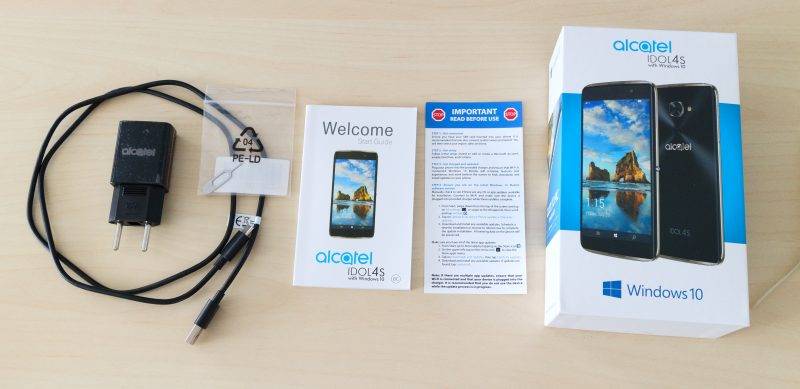
Сам телефон оставляет очень приятное впечатление, когда берёшь его в руку. Сборка не вызывает никаких нареканий, а боковые металлические грани вместе со стеклянными передней и задней частью смотрятся красиво. Кнопки нажимаются приятно и чётко.
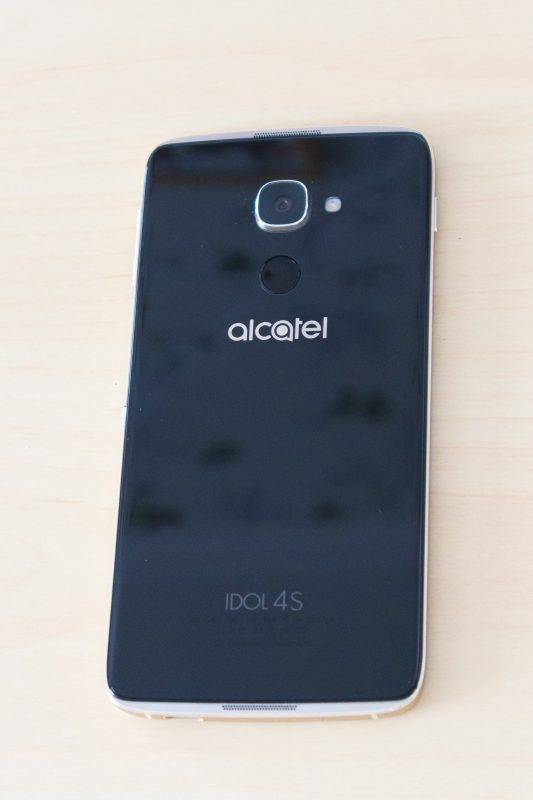
На левой грани расположена кнопка включения (после Люмий это кажется странным, но я привык очень быстро и нашёл свои плюсы у такого расположения), на правой – кнопка регулировки громкости, а также кнопка съёмки. Она включает телефон с запущенным на нём приложением камеры – очень удобно, когда хочешь что-то быстро снять. На верхней грани находится разъём наушников и микрофон, который участвует в подавлении шума при разговоре. Снизу разъём зарядки USB Type-C и основной разговорный микрофон.

У смартфона два динамика, что прекрасно для просмотра видео и прослушивания музыки в стереорежиме. Примеательно, что решётки динамика есть и спереди аппарата, и сзади, поэтому, как его не переворачивай и на что не клади, а звук всё равно будет слышен. Запас громкости вопросов и нареканий не вызывает.
Сзади расположена камера и сканер отпечатка пальца (про них ниже).
Дисплей телефона прекрасен. Это и глубокий чёрный, который не снился IPS-экранам, и огромный запас по яркости, которого хватит для чтения на ярком солнце, и прекрасно, безошибочно работающий сенсор. Кстати, производитель добавил включение двойным тапом и даже режим работы в перчатках. Олеофобное покрытие тоже присутствует – экран легко очищается от отпечатков.
Над экраном расположен светодиод белого цвета, который загорается при подключении телефона к розетке и гаснет при полной зарядке. Приятная мелочь, которой не хватало на Люмиях.
Многие иронизируют, говоря, что такое мощное железо не нужно системе Windows Mobile 10, но я с ними не соглашусь. По сравнению с бюджетными телефонами на этой же системе, у «Алкателя» огромная разница по быстродействию и отзывчивости в любых задачах. Особенно это заметно в программах с эффектами Fluent Design и браузере Microsoft Edge, который здесь не теряет вкладки и не перезагружает страницы от недостатка оперативной памяти.
Батарейка при умеренном использовании держится полтора-двое суток, что я считаю приличным результатом.
Программное обеспечение
Расписывать что-то о преимуществах, недостатках и перспективах Windows Mobile 10 я не буду, поскольку все и так всё прекрасно знают. Все же об особенностях работы системы именно на этом аппарате сказать кое-что стоит.
Первым делом свой Alcatel я русифицировал прошивкой четырёх файлов локализации, так как из коробки этого языка нет. Теперь он полностью на русском языке, включая голосовые функции и подсказки клавиатуры. Все это останется даже после хард резета. Инструкции можно найти в Интернете.
Производителем предустановлены несколько дополнительных программ, в основном для VR-очков (но я купил версию телефона без очков, поэтому опробовать их не могу). «Заставка» (Glance Screen), «Эквалайзер», настройки цветового профиля и прочие, характерные для телефонов серии Lumia опции, которые их производитель добавлял во вкладку «Дополнения» настроек, здесь отсутствуют. Зато есть запись разговора и функция Continuum.
Точность и скорость работы сканера отпечатка пальцев сильно зависит от того, как вы его настроите. При добавлении пальца нужно будет прикладывать его несколько раз, и захватить как можно большую площадь отпечатка. Тогда телефон разблокироваться будет с первого раза. Кстати, палец можно приложить даже при выключенном экране – он сразу включается. Добавить можно несколько пальцев.
Некоторый сторонний софт на этом телефоне ведёт себя странно: при звонках через WhatsApp собеседники жалуются, что меня плохо слышно, как будто звук берётся с верхнего микрофона, а также ужасно работает MyTube – программа виснет, видео смотреть невозможно, хотя на более слабых телефонах она работала быстро. Видимо, их разработчики не тестировали своё ПО на этом аппарате вообще. Возможно, багрепорт что-нибудь изменит.
Камера
В телефоне установлена матрица Sony IMX230 на 21Мп физического размера 1/2.4’’ и стекло (не пластик!) Sony Exmor RS со светосилой f/2.2. Оптического стабилизатора нет, автофокус работает весьма быстро и не промахивается, вспышка очень яркая, двухцветная.
Качество снимков вполне приличное, но до Lumia 950 ему далеко. Камера не очень хороша для пейзажной съёмки из-за агрессивного шумодава и вытекающего из этого последствия в виде мыльных снимков, но зато она отлично себя показывает в макросъёмке. Примеры фото без обработки:



Не понравилось отсутствие возможности съёмки в RAW (DNG) для последующей коррекции на компьютере. Такой опции в настройках камеры телефона попросту нет и включить её никому из пользователей с помощью изменений в реестре не удалось.
Съёмка панорам и режим HDR есть.
Связь
Аппарат нормально ловит сеть, слышимость собеседников отличная, они в свою очередьь тоже не жалуются. Телефон поддерживает частоты LTE 2, 4, 5, 7, 12, 17, что не сосвем совпадает с типичными частотами российских сотовых операторов. Но, к счастью, в моём регионе у моего оператора есть 7 частота, поэтому, после указания вручную в настройках точки доступа LTE, у меня он заработал на нормальной скорости.
Wi-Fi работает нормально не только на 2,4Гц, но и на частоте 5Гц, в отличие от Люмий. Спутники ловятся так же быстро, как и на Люмиях, хотя ГЛОНАССа тут нет.
В итоге можно отметить следующие плюсы и минусы устройства, обнаруженные за время его использования:
Плюсы:
- Самый мощный и современный процессор, видеоускоритель, а также самый большой объём ОЗУ среди телефонов на Windows Mobile, наряду с HP Elite X3.
- Прекрасный экран.
- Режим работы в перчатках.
- Отличный дизайн.
- Хорошая автономность.
- Быстрая зарядка в комплекте.
- Качественный звук из стереодинамиков.
- В природе есть версия Alcatel Idol 4S на Android, идентичная нашей по размерам и корпусу, благодаря этому на телефон есть масса аксессуаров.
Минусы, куда же без них:
- Отсутствуют некоторые частоты LTE, используемые российскими операторами (этой проблемы нет у его европейской версии – Alcatel Idol 4 Pro).
- Отсутствие некоторых характерных для телефонов серии Lumia настроек и опций.
- Отсутствие возможности установить вторую сим-карту.
- Слишком агрессивный шумодав у основной камеры, мылящий снимки, и невозможность съёмки в RAW.
- У моего экземпляра в полной тишине можно услышать лёгкий фон из верхнего динамика при запуске программ, работе в браузере.
- Некорректная работа некоторого стороннего софта.
Если у вас есть вопросы относительно этого смартфона, задавайте их в комментариях.

You should upgrade or use an alternative browser.
-
#101
Welcome 2019. According to gus33000’s blog (https://gus33000.me/2019/01/05/secureboot-flaw-for-all-wp-devices-literally/), our Alcatel IDOL 4S bootloader can be unlocked. As the hardware of Idol 4S is still capable for running Android Oreo/Pie, can we restart the porting Android to this phone? I love the Idol 4S but its softwares now outdated and cannot use as main phone.
Just saw this old article. I’d be more interested in running regular W10 on this thing. Anyone able to do that?
-
#102
Just saw this old article. I’d be more interested in running regular W10 on this thing. Anyone able to do that?
Ya this particular non-lumia windows phone to me was the most hackable. Before even WPI new version was released folks had already discovered developer roms and had mass storage mode access. I have contemplated buying a couple more of these so when I find time I could dabble with one again. The issue with woa on this much like the hp elite x3, (which it too should be unlockable) is that the drivers would need to be created from scratch. There is litterally very little starting point on these two unlike the Lumias. However there are a couple of sites out there where folks have continually dug into the idol 4s and have even found a way to Sim unlock them…
-
#105
…and as I suspected
did you try the WoA telegram group?
Yes, I asked in telegrams in the arm32 group, they advised me to try a test driver that is suitable for all lumias on arm32, it didn’t fit an idol, the touchscreen still doesn’t work, it’s sadness.
-
#107
(I have the unlocked variant btw if necessary info)
-
#108
Hello, I am struggling right now with this device. I would certainly like to see what could be done with the device when it comes to custom software but as of right now, It appears first that I need to enable interop to get to that stage, however I have been stuck trying interop unlock my device. I think it would be because I am running W10M 1709, and not a Lumia device, so I cant make it to the stage to disable secureboot. Anybody has any info or guide that would work for this device. I am not a complete novice new to the Windows Mobile development scene, having dabbled in it to upgrade my unsupported Lumia530 to W10M Preview, additionally I am fairly versed in the android one, but I just cant find a way to either get past interop, or even downgrading the OS to a build that interop unlock works in. Thank you regardless for reading.(I have the unlocked variant btw if necessary info)
Hey there. There is a method Guss shared a while ago that allows the unlock or secure boot bypass for this device and possibly even the elite x3. Here.
As far as interop unlocking etc that method is known and can be found on his xda thread for his interop tools app.
-
#109
Hey there. There is a method Guss shared a while ago that allows the unlock or secure boot bypass for this device and possibly even the elite x3.As far as interop unlocking etc that method is known and can be found on his xda thread for his interop tools app.
Yup, I’ve been trying to follow it, however, the guide states itself states that one requires Windows 10 Mobile 10586, or the The November Update from 2015, I am on The Fall Creators update from 2017, is there a way for this versionto be interop unlocked? Also I have been trying to downgrade to Windows 10 Mobile 10586, but Factroy reset does not do the trick and Windows Device Recovery Tool keeps running into an error and I am not sure that it would downgrade the OS even if it did. Thank you regardless.
-
#110
Yup, I’ve been trying to follow it, however, the guide states itself states that one requires Windows 10 Mobile 10586, or the The November Update from 2015, I am on The Fall Creators update from 2017, is there a way for this versionto be interop unlocked? Also I have been trying to downgrade to Windows 10 Mobile 10586, but Factroy reset does not do the trick and Windows Device Recovery Tool keeps running into an error and I am not sure that it would downgrade the OS even if it did. Thank you regardless.
You would need to find the ROM of the build and flash it… IF that is part of the directions.
———- Post added 30-12-2019 at 12:41 AM ———- Previous post was 29-12-2019 at 11:47 PM ———-
Hi what exactly are you trying to do with the Alcatel Idol 4S? Are you trying to interop unlock full file system access? Or are you trying to Bootloader unlock or secure boot bypass the idol 4S?
Last edited:
-
#111
You would need to find the ROM of the build and flash it… IF that is part of the directions.———- Post added 30-12-2019 at 12:41 AM ———- Previous post was 29-12-2019 at 11:47 PM ———-
Hi what exactly are you trying to do with the Alcatel Idol 4S? Are you trying to interop unlock full file system access? Or are you trying to Bootloader unlock or secure boot bypass the idol 4S?
The latter for sure however, I really don’t know how to «backup/replace resetphone.efi» to «Install developermenu.efi» and the gus33000 later states «Interop Unlock requires Windows 10 Mobile 14393 or earlier so a reflash will most certainly be required.» making me believe that Interop Unlock is required or at least Interop Tools is required to have this functionality
(edit: I did manage to downgrade to W10 1607 build 14393 by using Windows Recovery Tools and flashing the T-Mobile instead of Open Market)
Last edited:
-
#112
The latter for sure however, I really don’t know how to «backup/replace resetphone.efi» to «Install developermenu.efi» and the gus33000 later states «Interop Unlock requires Windows 10 Mobile 14393 or earlier so a reflash will most certainly be required.» making me believe that INterop Unlock is required or at least Interop Tools is required to have this functionality
Ah OK. To run interop tools in order to gain full file system access you do not need to have the boot loader unlocked. And you can run almost any version of W10M. However I have not read his directions in detail pertaining to resetphone.efi. It’s possible in order to disable secure boot in addition to that step an older version is needed one that might not have patched areas of discovered vulnerability. I am only speculating though since I have not attempted this yet. I kinda wish I had saved all my elite x3 ffu files. I only kept a couple of them but hp had several fw updates and the ffu was usually available via the wdrt. I had all of them for that phone and they would have come in handy for downgrading the elite x3 for purposes like this.
-
#113
Ah OK. To run interop tools in order to gain full file system access you do not need to have the boot loader unlocked. And you can run almost any version of W10M. However I have not read his directions in detail pertaining to resetphone.efi. It’s possible in order to disable secure boot in addition to that step an older version is needed one that might not have patched areas of discovered vulnerability. I am only speculating though since I have not attempted this yet. I kinda wish I had saved all my elite x3 ffu files. I only kept a couple of them but hp had several fw updates and the ffu was usually available via the wdrt. I had all of them for that phone and they would have come in handy for downgrading the elite x3 for purposes like this.
It kind of seems like I just assumed that Interop Tools were required to have the capability to unlock the bootloader, I just would like to unlock the boot-loader only since for the time being I want to experiment with WOA or perhaps even getting android on the device though that seems like a dead end on the thread dedicated to so. My only priority I would think would be unlocking the bootloader but I just cant decipher gus3300’s guide
-
#114
It kind of seems like I just assumed that Interop Tools were required to have the capability to unlock the bootloader, I just would like to unlock the boot-loader only since for the time being I want to experiment with WOA or perhaps even getting android on the device though that seems like a dead end on the thread dedicated to so. My only priority I would think would be unlocking the bootloader but I just cant decipher gus3300’s guide
It very well might be needed installing to disable secure boot. I’m not so sure about Android running on these as it would require dual booting most likely or something fancier. Last time I checked Android could be installed on it with the TCL 950 China ROM but it ends up wiping certain partitions needed for cellular along with the imei data. I don’t thing they have a programmer to flash it with a «flat file» img or Android ROM properly. But maybe I am wrong.
-
#115
It very well might be needed installing to disable secure boot. I’m not so sure about Android running on these as it would require dual booting most likely or something fancier. Last time I checked Android could be installed on it with the TCL 950 China ROM but it ends up wiping certain partitions needed for cellular along with the imei data. I don’t thing they have a programmer to flash it with a «flat file» img or Android ROM properly. But maybe I am wrong.
Unless dual booting is necessary, I’m not too interested in having that option. I see that people here have already gotten Windows on Arm, which I would be really curious but the obstacle remains, I haven’t managed to unlock the bootloader. perhaps if anyone would be up for updating gus33000’s blog post more friendly to novices. On a side note, what could somebody do with Interop Unlock? Idk what that program is capable of. Better said, where can I best get versed in W10 development and hacking, I may have been way over my head with this one.
-
#116
I installed ARM32 on a retail IDOL 4 Pro, but the touchscreen does not work, so I can’t go through the initial settings, maybe someone knows where to get a working driver for thetouchscreen , those few that I tried from lumias (arm32) do not work.
https://4pda.ru/forum/index.php?s=&showtopic=952858&view=findpost&p=92186848
I have not gotten that far and the files are not available. What tools did you find to install a new bootloader?
Any help is appreciated.
Similar threads
After launching the Android Marshmallow-based Idol 4S at MWC earlier this year, Alcatel has launched a Windows 10 Mobile variant of the Idol 4S. The smartphone is exclusive to T-Mobile, and is priced at $469.99 (roughly Rs. 31,500). T-Mobile will begin selling it from November 10, and will bundle the Idol 4S VR Goggles inside the box.
Alcatel Idol 4S (Windows 10) buyers will get free 45-day trial for Hulu Plus, as well as an additional 30-day trial for Microsoft Groove music service. They’ll also receive a free copy of the Windows 10 Mobile game Halo: Spartan Assault.
The Alcatel Idol 4S (Windows 10) variant looks just like the Android variant, but has many differences when it comes to specifications. It features a 5.5-inch HD (1080×1920 pixels) AMOLED display, instead of the QHD display seen on the Android version. The new smartphone is powered by a Snapdragon 820 chipset with Adreno 530 GPU and 4GB RAM, instead of the Snapdragon 652 chipset with Adreno 510 GPU and 3GB RAM seen on the previously launched Idol 4S.
The dual-SIM, Windows 10 Mobile-based Alcatel Idol 4S (Windows 10) sports an upgraded 21-megapixel rear camera with touch focus and dual-LED flash. To recap, the Android variant sports a 16-megapixel rear camera. At the front, the 8-megapixel selfie camera with real-time face beautification and LED flash remains the same.
The storage bundled internally has also been increased to 64GB, and it can be further expanded using the microSD slot (up to 128GB). There are also dual-firing stereo speakers on the Windows 10 variant.
The Idol 4S (Windows 10) smartphone measures 153.9×75.4×6.99mm,weighs 152 grams, and is backed by a 3000mAh battery, which is rated to charge within 95 minutes via the Quick Charge version 2.0.
Connectivity options include 4G LTE (Cat 4.), Wi-Fi 802.11 a/b/g/n/ac, Wi-Fi Direct, NFC, Bluetooth 4.1, GPS and Micro-USB (with OTG). The Idol 4S (Windows 10) will come in an all-glass black-coloured body with gold metallic edges.
Windows 10 on mobile… it’s not dead, it’s just resting. While the world waits for the currently mythical Surface phone, Windows 10 needs a smartphone to champion its mobile ambitions. The previous Lumia flagships from 2015 need to be replaced. Can Alcatel’s Idol 4S be that handset?

There’s a lot going on here, and the best way to do this is to break it down by the handset’s full name. Take a deep breath and join in… «the T-Mobile Alcatel Idol 4S with Windows 10 — Virtual Reality Included» package.
First up, T-Mobile. This handset allows the network to offer a modern Windows 10 powered handsets to its customers. While Windows 10 Mobile phones may not be making a huge impact on the market share statistics, there are circumstances where Microsoft’s operating system will be a good fit for a customer. The focus here is probably on the enterprise market.
With the best will in the world, 2015’s Lumia 950 and 950 XL handsets are getting a bit long in the tooth. With the Surface Phone unlikely to show up in the near future the landscape is clear for a Windows 10 handset to come in and claim the flagship crown. This is that handset.
Alcatel is smart enough to realise that this is not going to be a huge selling handset. That means the economy of scale required in manufacturing cannot be found in the volume of units sold of the Windows 10 handset. Luckily there are other ways of finding scale. The Idol 4S for Windows 10 is built on a common hardware platform and eagle-eyed smartphone followers will recognise the Idol 4S as an Android-powered device released in mid-2016; others may recognise it as the BlackBerry DTEK60; now we can add Windows 10 into the mix.
This says something comforting about Windows 10 — that it runs on a reference design platform, that it does match up hardware wise with Android devices of the same class, and if manufacturers decide to move forward and implement Windows 10 powered mobile devices during 2017 (or, more likely in 2018 when the Redstone 3 update to Windows 10 brings more mobile features) then the design work in their Android handsets can be recycled.
The Idol 4S platform offers solid specifications for a handset that is pushing towards the premium end of the market, but is still able stay within a sensible budget. The Windows 10 version bumps the processor up to a SnapDragon 820 with 4GB of RAM. It has a 21 megapixel camera, and moves from microUSB to USB-C for desktop connectivity and charging. One area that sees a drop in specification is the screen, moving down to a 1080p display from QHD on the Android handsets.
In regular use I think this was the right choice to go with higher chip specifications and make back the budgetary balance on the screen. Microsoft’s mobile devices have always been incredibly economical with real estate, and the screen never feels cramped or lacking in information even though 1080p is the minimum table stake for a mid- to high-end handset.
Performance is curious. The SnapDragon 820 is close to the top of the performance tree (at least for a handset released late in 2016) and its paired up with 4 GB of RAM. The built-in apps are smooth, you can switch between them with ease and the experience is as you would expect given the specifications. Third-party applications are slower. Loading times, switching to apps from the multitasking view, it just feels like a slower machine than it should be. Something just feels a little bit off. How much this affects you comes down to the Windows 10 question of how much you will rely on the built-in apps compared to third-party experiences.
I’m less enamoured with the physical layout of the Idol 4S design. With the power button high on the left-hand edge in a normal grip the power button is inaccessible. More than that, my natural grip rests over the camera shutter button. Muscle memory of reviewing countless handsets has me thinking this reachable and distinctive button is the power button and not the camera button. It remains an annoyance even at the end of the review period. This is mitigated if you set up the fingerprint sensor on the back of the device to unlock the Idol 4S, but the lag between scanning the finger and the handset jumping to the home screen is uncomfortably long.
I’m not going to dwell too long on Windows 10 as an operating system. It’s a known quantity to me, and with the Idol 4S with Windows 10 arriving in mid-cycle for the OS there’s nothing that I would regard as new in the package. It retains the advantages of Windows 10, with live tile support on the home screen offering buckets of ‘glance and go’ information and customisation. It comes with a PIM suite that easily syncs to your Microsoft account and the integration with Microsoft’s cloud services (including Outlook 365, photo storage, backup, and the Groove music service) is as polished as you would hope.
You can’t get away from the a chillies heel of Microsoft’s mobile efforts… there is a shortage of apps. Yes the big names are now pretty much covered in some form (your Facebooks, Twitters, and Instagrams of the world are all here), but if you’re looking for the latest online services out of Silicon Valley you’re going to be looking in the Windows App Store for a long time. Microsoft has tried many approaches to this over the years but the problem remains.
Your one saving grace might be using the standards-compliant web browser, but it’s not going to suffice in every circumstance. Anyone purchasing a Windows 10 powered smartphone needs to be aware that what you get in the box and what you can see online when you order the handset may be all you are going to get for the handset. That’s probably enough for Enterprise users and those who want a smartphone to help organise life as opposed to being a tool for leisure and entertainment, but the strong base of built-in apps is all you should count on.
Next: The power of VR…
Moving on to the last building block of the title, the retail packaging includes a VR headset. It’s a slight step above the basic VR headset, with two ‘soft buttons’ on the base of the headset allowing you an ‘action’ and a ‘back’ button as well as the usual tilting head methods of control.
New realities are everywhere, but this feels just a little bit gimmicky. First up, the app gap on Windows 10 for mobile kicks in again with very few apps available beyond those that are pre-installed on the handset. Both Zombie VR (an ‘on rails’ look to shoot 3D action game) and Captain Fellcraft VR (an infinite ‘into the screen’ flying game) are good demonstrations of the potential of VR on a mobile device, but they have very little depth or replayability.
There’s more to look at when you log into the YouTube 360 video app and can start exploring the world of 360 degree videos, but the look of VR suffers from the design choice to move down from the QHD screen 1080p resolution. Splitting that between each eye offers a low pixel count and visible pixelation is unavoidable.
One advantage of the Idol 4S design is that it employs two forward facing speakers at the top and bottom of the device. This provides a genuine stereo sound when the handset is strapped into the headset. Audio-wise this is probably the best design for the ‘phone as VR’ genre.
The Idol 4S with Windows 10 is a competent phone. The specifications are modern enough that it feels future-proofed for the upcoming Windows 10 software updates expected in 2017, it meets the expectations of a modern smartphone, and it is possible to live with the mobile version of Windows 10 and have it help organise your life.
I wonder if it’s possible to recommend and not recommend the Idol 4S?
This is not a handset to convert people to Windows 10 on mobile. The specifications are solid but the performance isn’t quite there; the camera is good but doesn’t stand out and the choices made for the physical buttons do not feel natural. There’s nothing wrong with the Idol 4S as a Windows 10 device, but there’s nothing particularly sexy or exciting about it. It’s the definition of a workhorse handset.
Yet having a modern workhorse handset is a good thing for Windows 10. It’s important to have more than Microsoft manufacturing the handsets and Alcatel has shown other manufacturers a potential way forward to work with Redmond and to get Windows 10 handsets onto the market.
As personal data moves towards the cloud, Microsoft is in a much better position to capitalise than it was with the older Windows Phone approach to mobile. The Idol 4S is not the only way to use Microsoft’s cloud on a mobile device (thanks to iOS and Android apps from Redmond) but it is the one that has the tightest integration. There’s a familiarity if you use Windows 10 on the desktop, and if you are committed to Microsoft’s cloud then the synergy between cloud, desk, and mobile will outweigh the ecosystem issues.
Disclaimer: T-Mobile USA provided an Alcatel Idol 4S with Windows 10 for review purposes.
Now read about Microsoft’s latest new frontier as I experience the HoloLens….
The smartphone market is almost completely unrecognisable from just five years ago. Back then the Windows Phone platform was tightly controlled by Microsoft and only available on (since deceased) Nokia phones.
Our quick take
There’s no doubting the hardware capability of the Idol 4S — we’ve seen it at work several times on Android. What’s disappointing in the Windows 10 version is the lack of optimisation from a software standpoint. With its slow loading — and that’s despite a hardware boost — it can be quite an off-putting experience.
Having launched initially as a T-Mobile locked exclusive, the Idol 4S running Windows 10 is available unlocked direct from Microsoft in the States and Canada for $470.
For those who want a seamless experience between their PC and mobile worlds it might still make sense to buy a Windows-based phone. Likewise, if you’re invested in the Windows 10 mobile ecosystem, the Idol 4S might make a nice update to a tired old Lumia.
However, with its restricted availability and the limited number of quality apps compared to Android and iOS, it’s difficult to recommend the phone with this software to most consumers. We’re not sure there’s any saving Windows 10 on mobile now.
Alcatel Idol 4S with Windows 10: The alternatives to consider
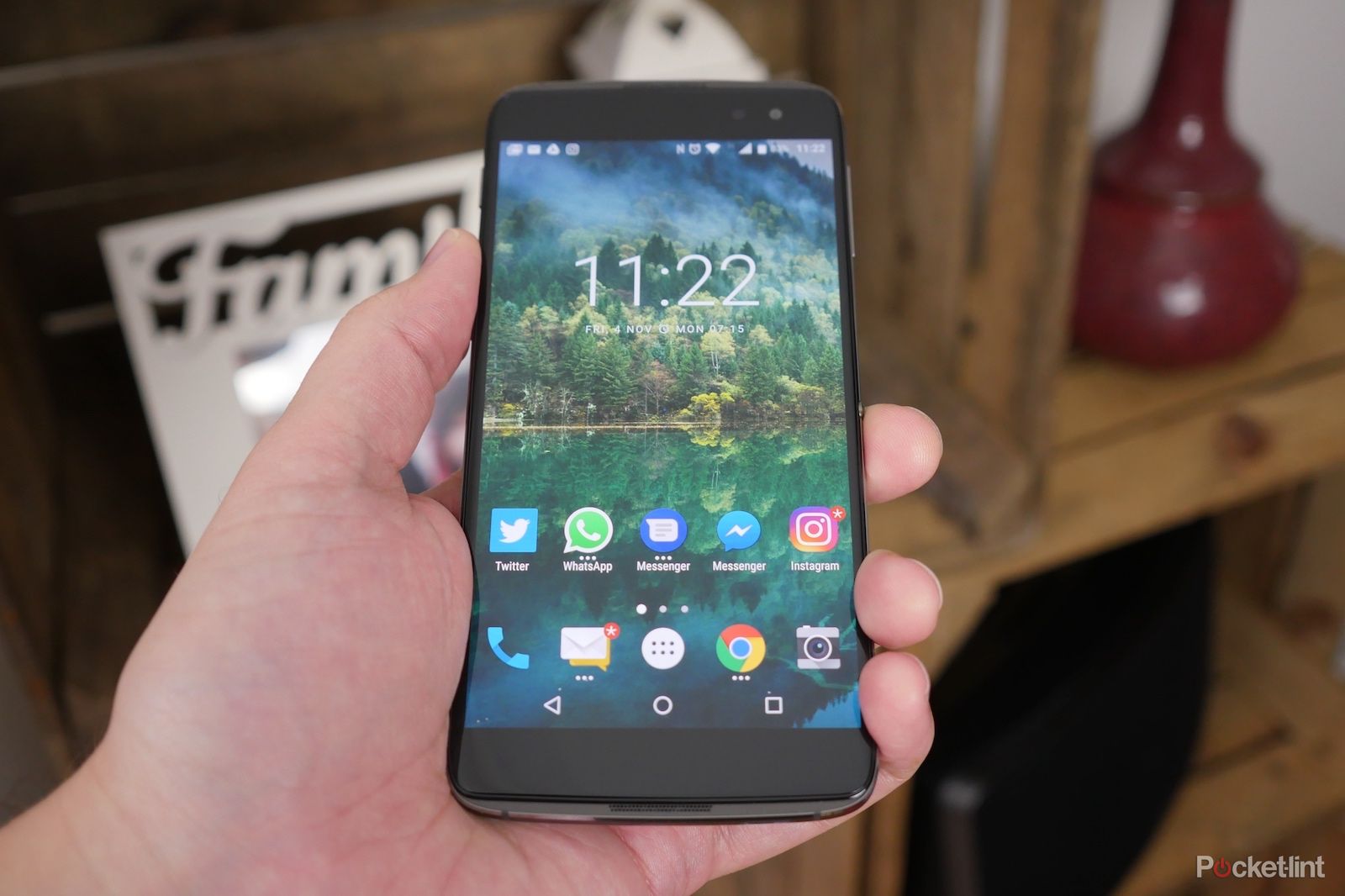
BlackBerry DTEK60
- £475
The DTEK60 fixes a lot of the Windows-based Idol 4S’s shortcomings. It has a higher-res Quad HD screen and runs Android Marshmallow with BlackBerry’s own custom apps and software. It’s faster, snappier and has tons of reliable apps available too.
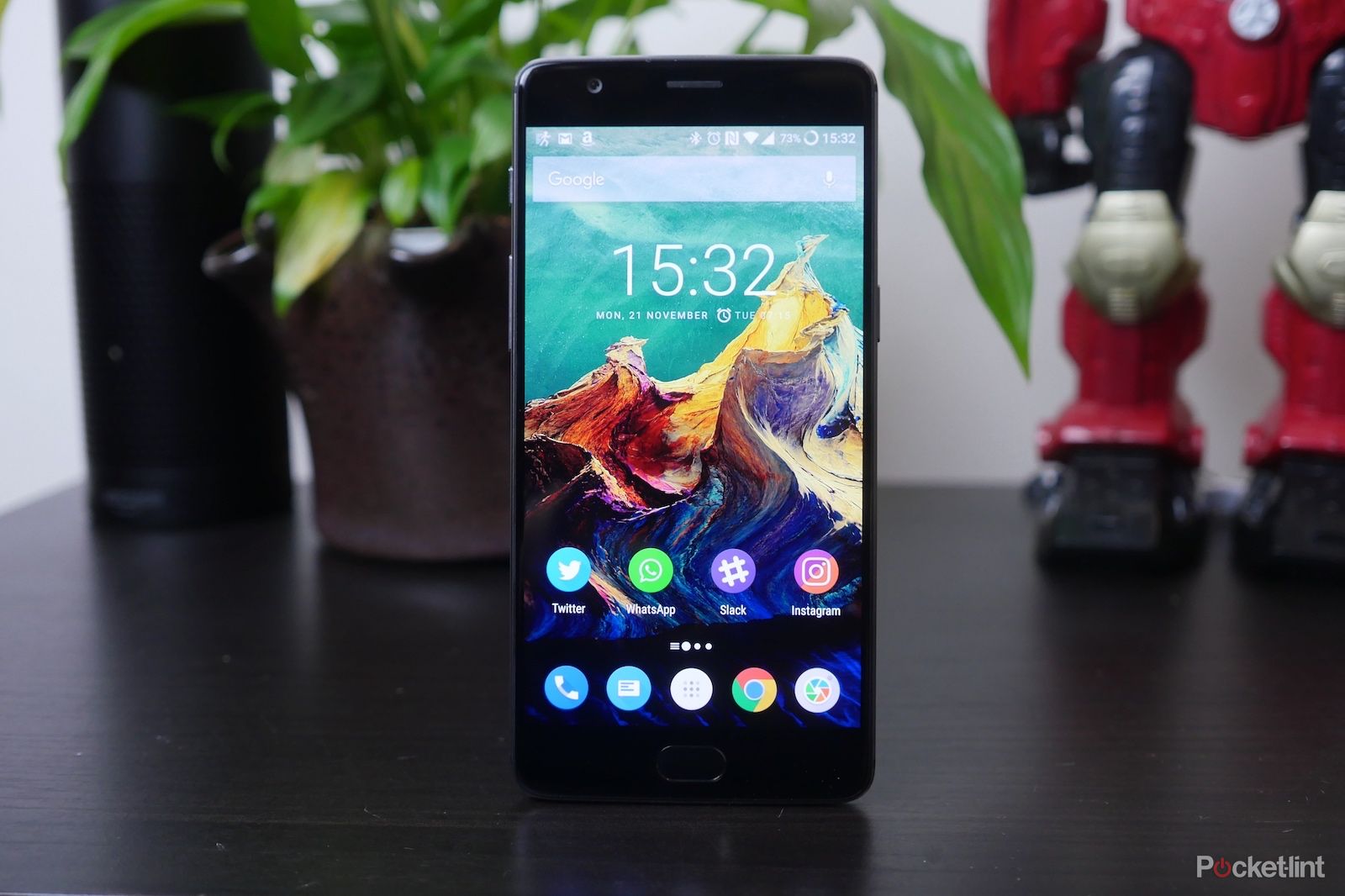
OnePlus 3T
- £399
The OnePlus 3T — like its predecessor — is a brilliant, fast and well-made smartphone loaded with a clean and lightweight custom version of Android. It has the same screen size and resolution as the Idol 4S, but has a more solid construction and a more powerful Snapdragon 821 processor. What’s more, it costs less.
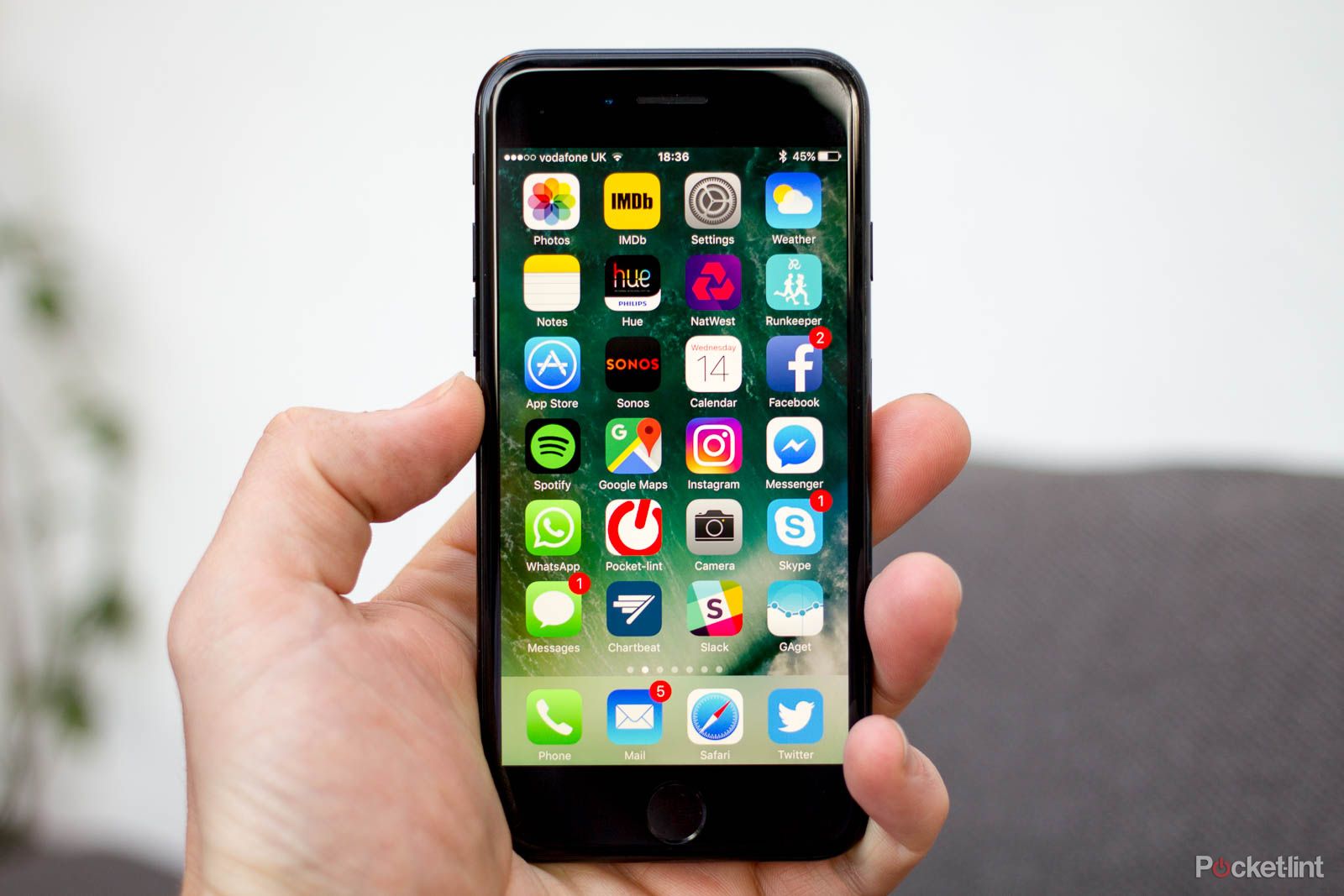
iPhone 7
- from £599
For something a little more expensive, and for what is considered the best supported app ecosystem, it’s hard to look past Apple. This year, the best of iOS is found in the iPhone 7 which, although much smaller than the Idol 4S, performs incredibly well across its many features. Battery life isn’t as good though.
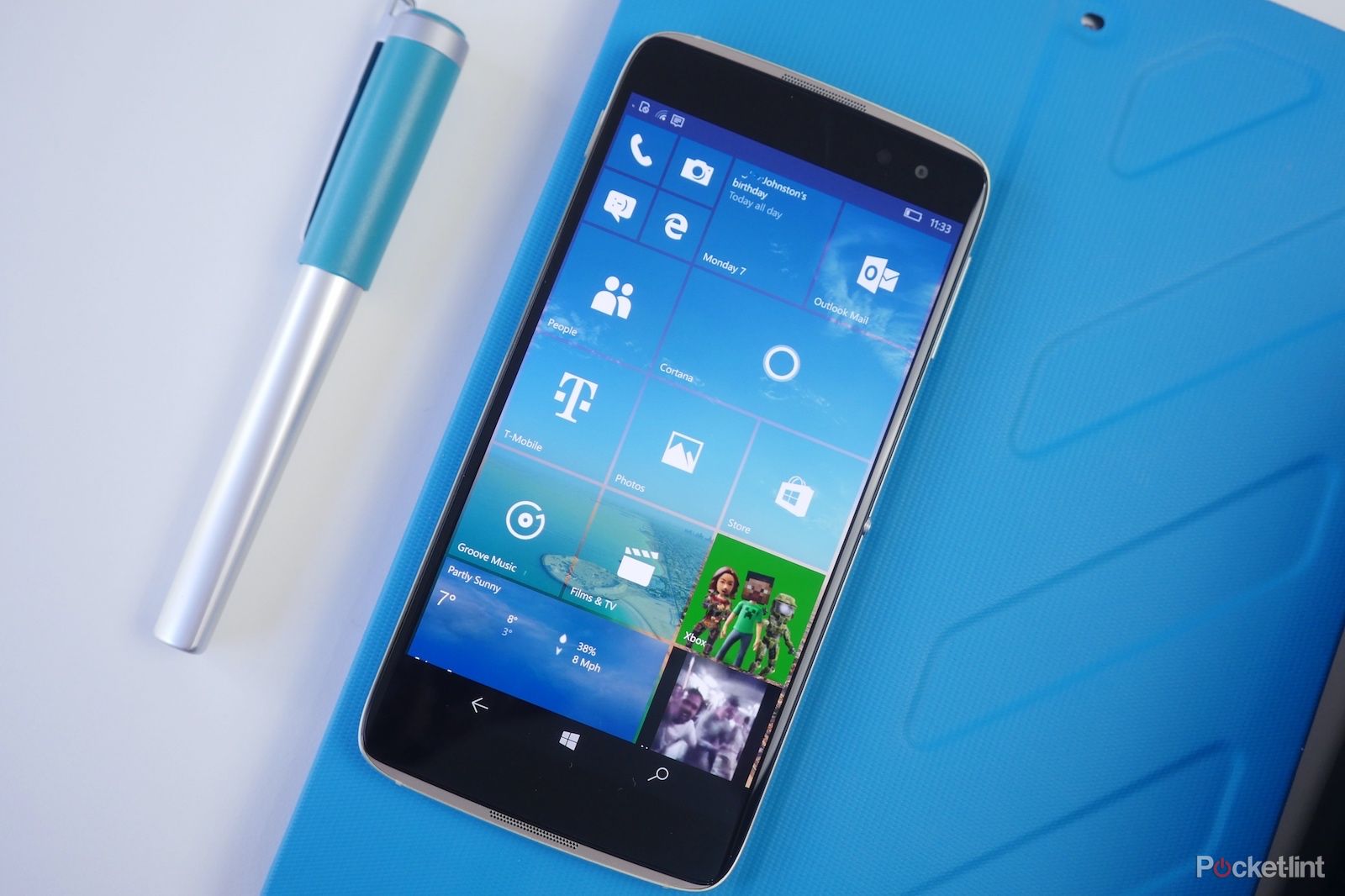
Alcatel Idol 4S with Windows 10 — 3.5 / 5
| FOR | AGAINST |
|---|---|
|
|
Alcatel Idol 4S
Amazon
But we’re talking about an era when BlackBerry made its own keyboard phones that used the company’s own operating system. Now BlackBerry, with its DTEK60, uses the touchscreen Alcatel Idol 4S with an Android operating system as its flagship. It’s a big, yet decent phone.
So the perfect device to save a flagging Windows 10 mobile then? Alcatel seems to think so with this variant. But is the Idol 4S in this form really worth anyone’s time?
Alcatel Idol 4S with Windows 10 review: Design
- 154 x 75 x 7mm, 149g
- Metal frame design
- Glass front and rear
We first got a glimpse at the Alcatel Idol 4S at the beginning of 2016 at Mobile World Congress (WMC) in Barcelona. We’ve since seen exactly the same build, materials and shape in the aforementioned BlackBerry DTEK60 and the Vodafone Smart Platinum 7. In short — it’s a familiar design, to say the least.
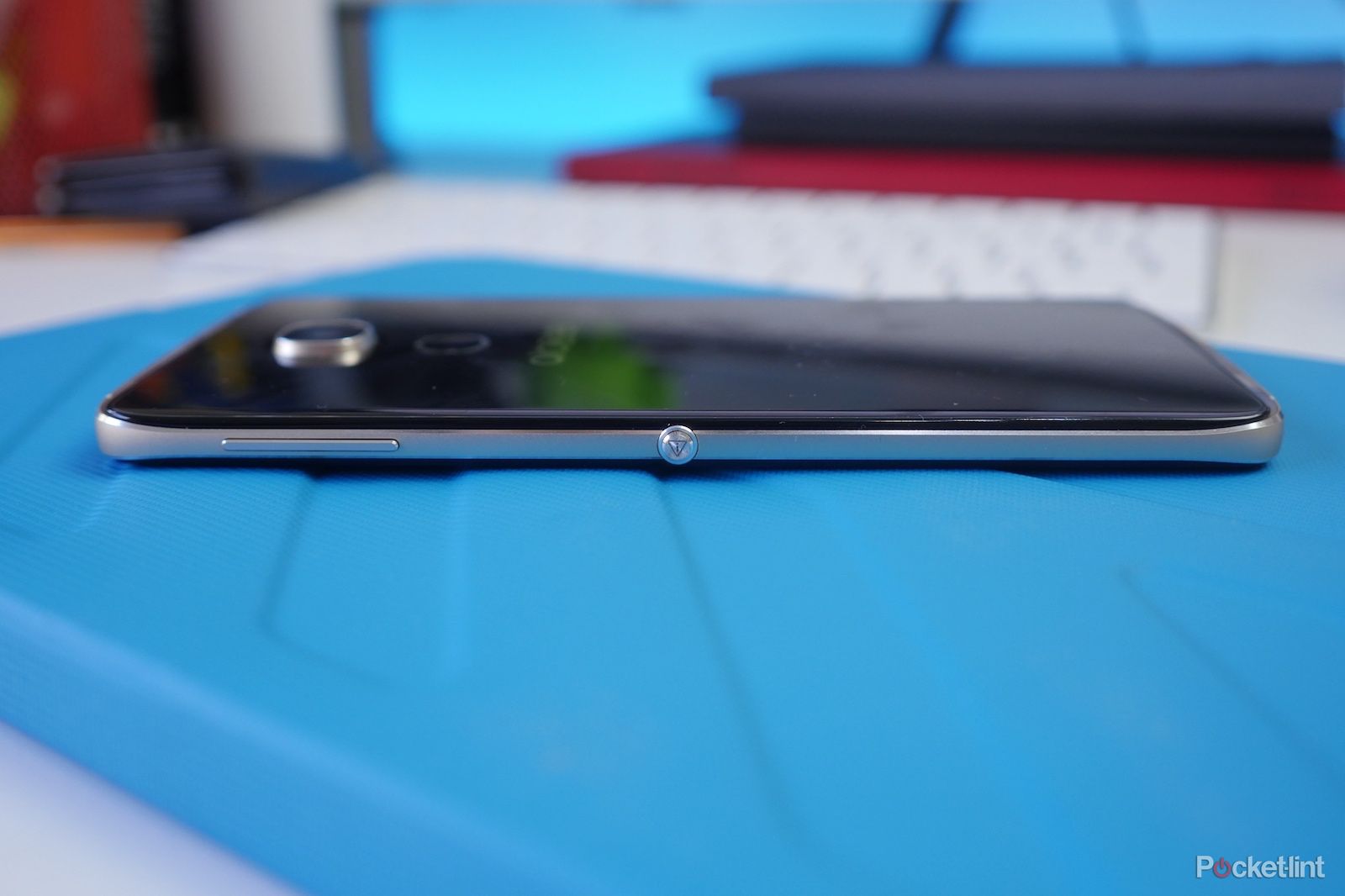
It’s probably no surprise that this Windows version looks almost exactly the same as its Android-based counterpart. The only real difference is its Type-C port in the Windows version (not Micro USB), as used for charging and transfer.
The Idol 4S’s front-and-rear glass panel build has an interesting reflective property where any light that hits it forms multiple shards of light that centre in on the fingerprint sensor. Those glass surfaces have subtle curves towards their edges, so look elegant, but it’s not quite enough to stop the phone feeling like a big shiny block in your palm — albeit a better one than if it was all completely flat lines and sharp right angles.
So while the finish and design is undoubtedly polished — those gold metal edges add a hint of luxury to the obsidian-like black glass — there’s no getting away from the size of this device. It’s a big phone, even by 5.5-inch phone standards.
Because of the size, the power button lives just out of one-handed reach at the top of the left edge. Well, it’s perfect if you’re left-handed, but nigh-on impossible to reach with your right. Oddly, the more-convenient-to-reach button is the camera launcher on the phone’s right edge, just below the volume rocker.
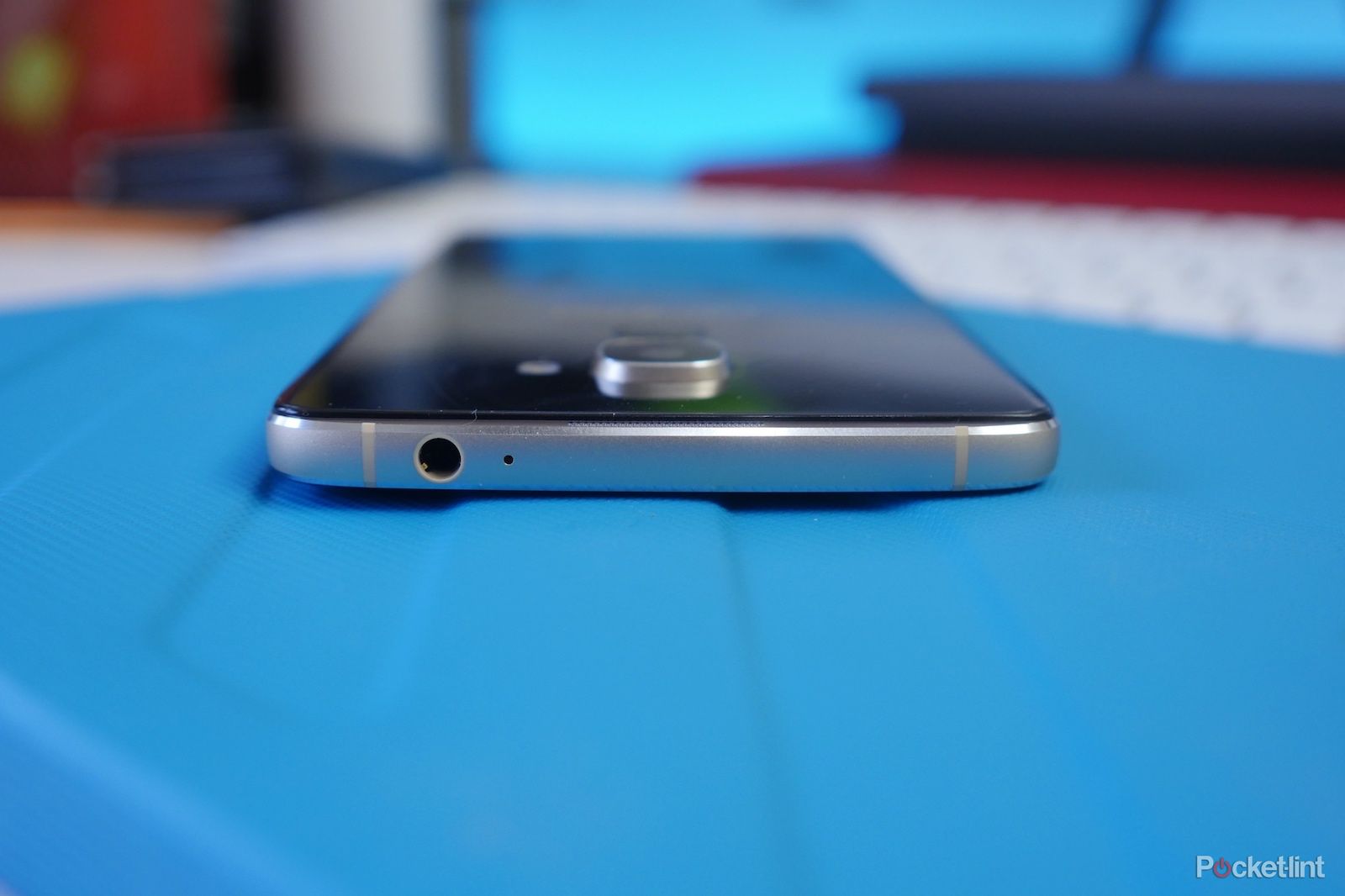
Then, as you may have spotted, there’s the massive protrusion that is the square camera bump on the rear. The aesthetic appeal is certainly up for debate, but this bump also brings an obvious disadvantage: it means the phone will not sit flat on any surface without wobbling about. Even worse, combined with those shiny glass panels, it will happily slip off the arm of a sofa onto the floor with seemingly zero encouragement.
Alcatel Idol 4S with Windows 10 review: Display
- 5.5-inch, 1920 x 1080 resolution
- AMOLED display
AMOLED technology and Windows 10 on mobile are made for each other. By default, the background on the phone is black which comes out completely dark on an AMOLED screen, because the screen technology can illuminate individual pixels for precision blacks sat next to bright whites.
The technology’s other strength is bright, saturated colours which, again, Windows 10 is full of. Colours are punchy and vibrant, while contrast levels are very high.
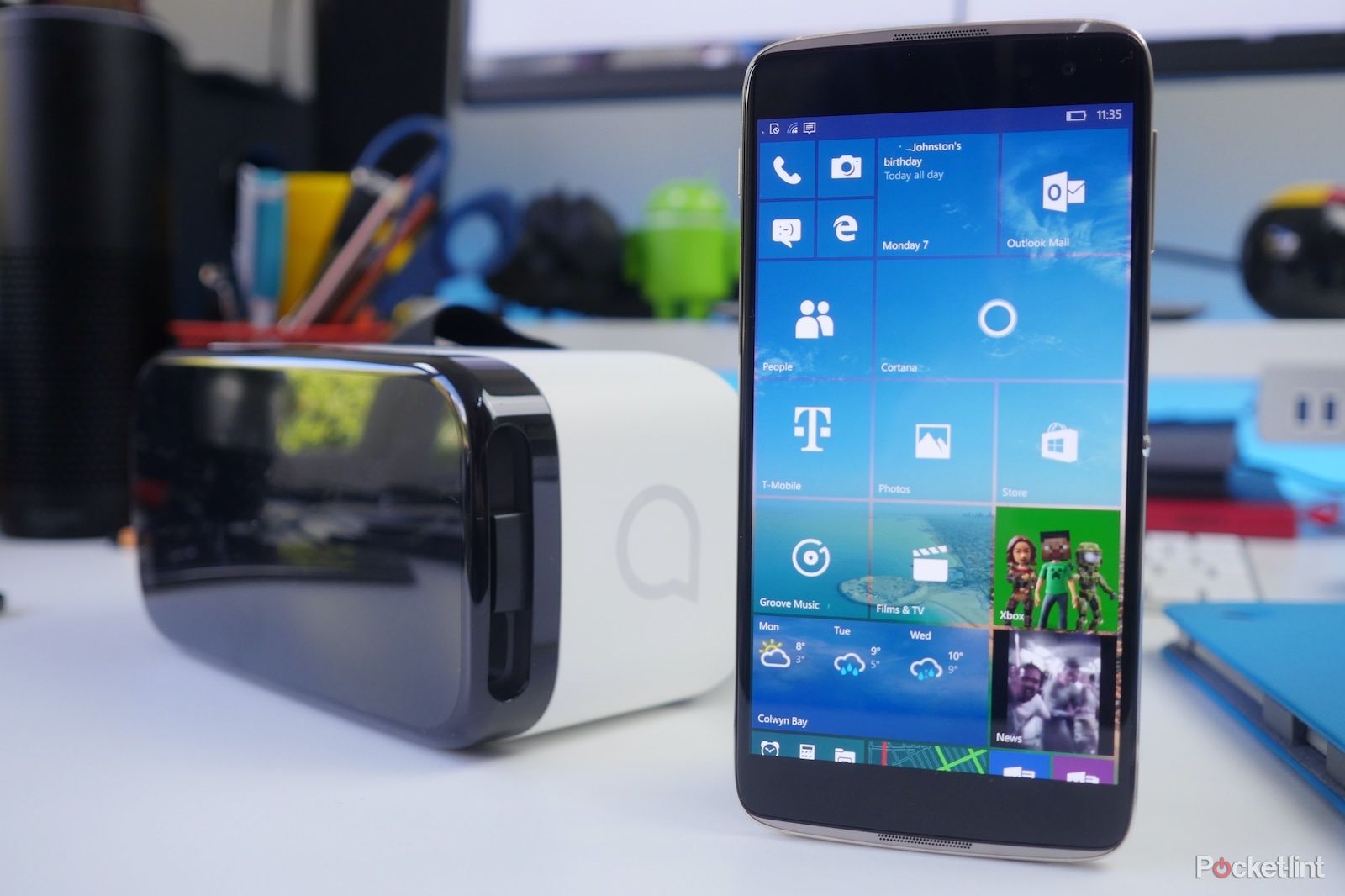
The 5.5-inch Full HD screen on the front of the Idol 4S is, therefore, both big and beautiful. On a phone this large the Full HD resolution does start to look a little bit rough around the edges compared to some other flagships — particularly around fine text, which Windows 10 uses aplenty — but it’s only really noticeable when you get very close to the screen.
As for gaming and watching video, the scale of this phone easily delivers enough real estate to enjoy all your favourite titles. That partners with stereo front-facing speakers to create a truly immersive experience. This is something you just don’t get on most phones which typically fire audio out of the bottom edge.
Alcatel Idol 4S with Windows 10 preview: Software
- Live tiles and searchable app list
- Cortana and Continuum are both included
- Mobile VR headset and apps come with the phone
- Windows 10 app store still lacking
You could be forgiven for thinking the Windows mobile platform was dead. After Microsoft decided to cut its losses on its smartphone hardware business, it seemed a no-brainer that the OS would die with it. But, seemingly, that’s not the case… yet. Windows 10 for mobile lives on to fight another day.
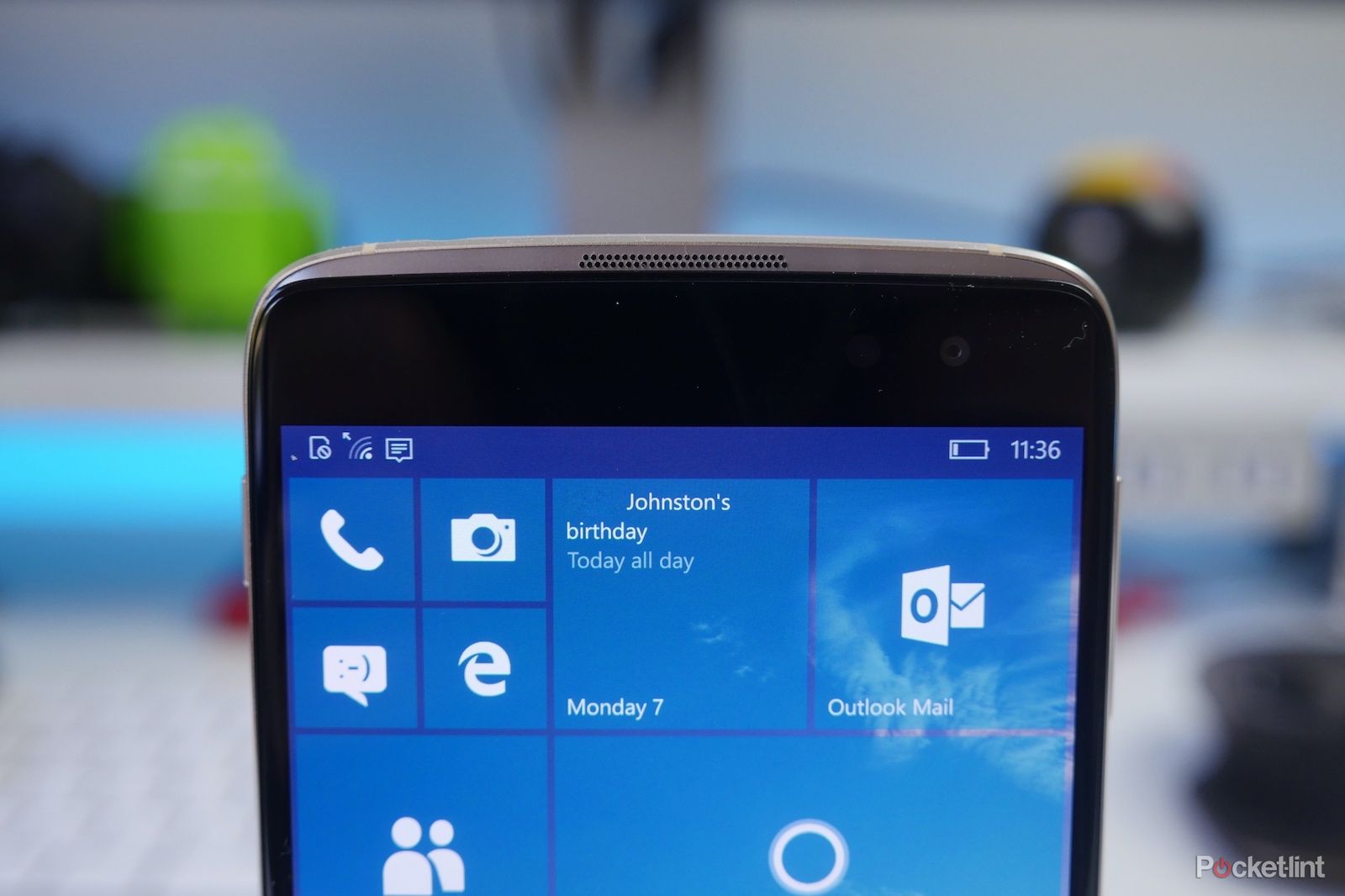
Like Windows Phone of old, the main home screen of the Idol 4S is filled with Live Tiles that update with quick snippets of information when you get notifications. You can resize them, re-arrange them and pin any app you want to this Start screen.
To some, having all this information on one screen may appear a little too busy, but there’s something rather pleasing about its convenience. Not having to swipe down for a notifications shade or open an app to see what the latest updates are is a time saver.
For those unfamiliar, Windows 10 for mobile brings many of the features across from the desktop operating system, including Cortana voice assistant, which is like Microsoft’s competitor for Apple’s Siri and Google Now. You can use it to search for things on the web, or set contextual reminders based on locations and meeting dates.
You can even train Cortana to recognise your voice by going through a relatively short set up process. By repeating a handful of preset phrases, Cortana learns how you say them and can be summoned at any time. Ignores other people’s voices, unlike most of the assistant’s competitors, is a bonus.
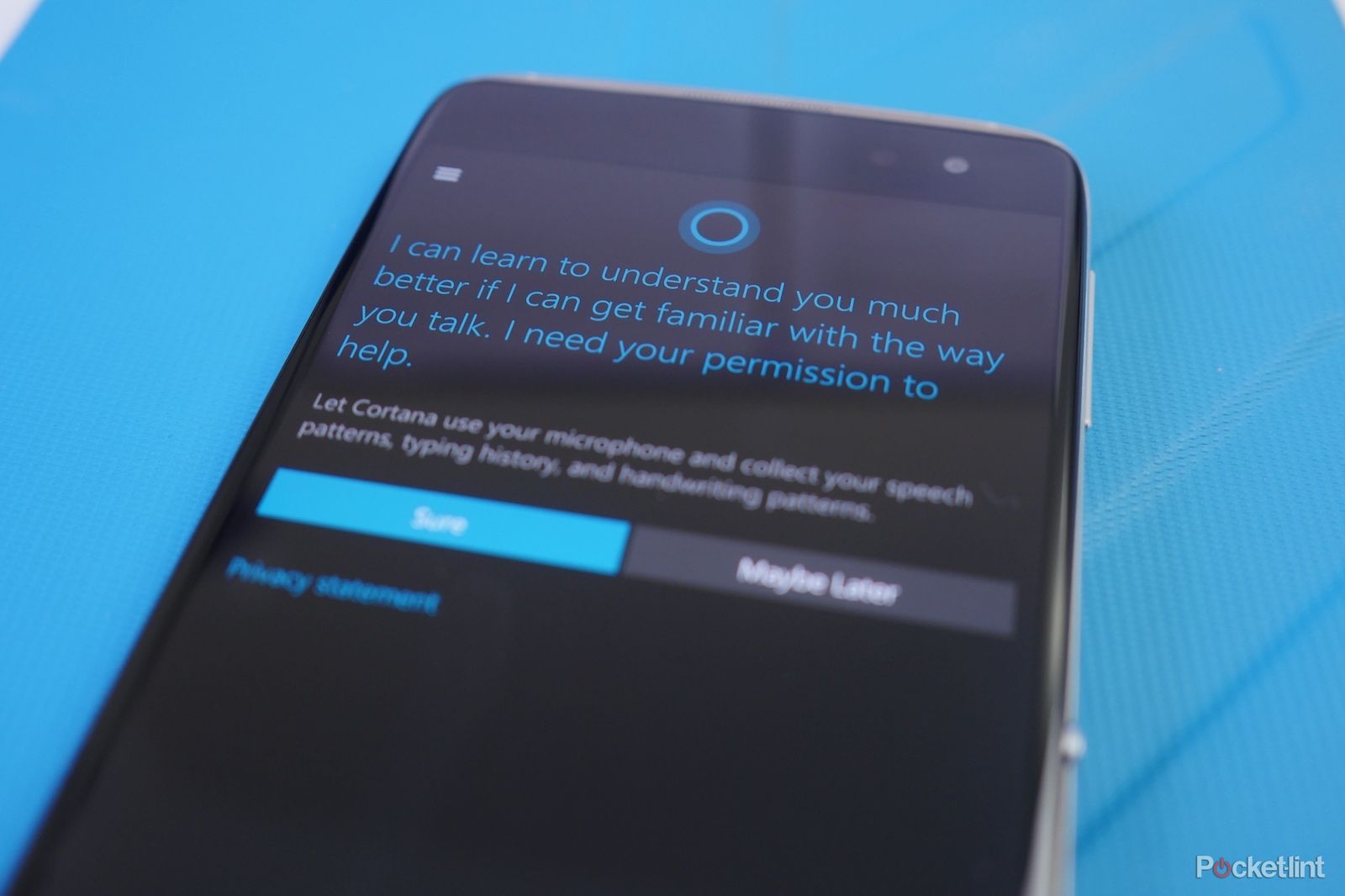
Interestingly, there’s also Continuum — Microsoft’s fancy word to describe its ability to be used as a desktop computer — albeit a limited version than normal. Plug the phone into a hub, or wireless connector, and you have a light version of Windows 10 delivered to a monitor, powered entirely by the phone.
Like the Android version, the Windows model of the Idol 4S ships with a VR headset and a handful of VR games. Sadly, the experience is about as poor as most mobile VR systems. The 1080p screen isn’t sharp enough, while the motion and animations aren’t quite smooth enough to make it a pleasant experience. It’s more a fun additional feature than a genuinely good experience.
While we like elements of Windows like the searchable app list, the customisable Live Tiles, and the easy typing keyboard, Windows still has one main issue on mobile: apps. Or rather, the lack of them.
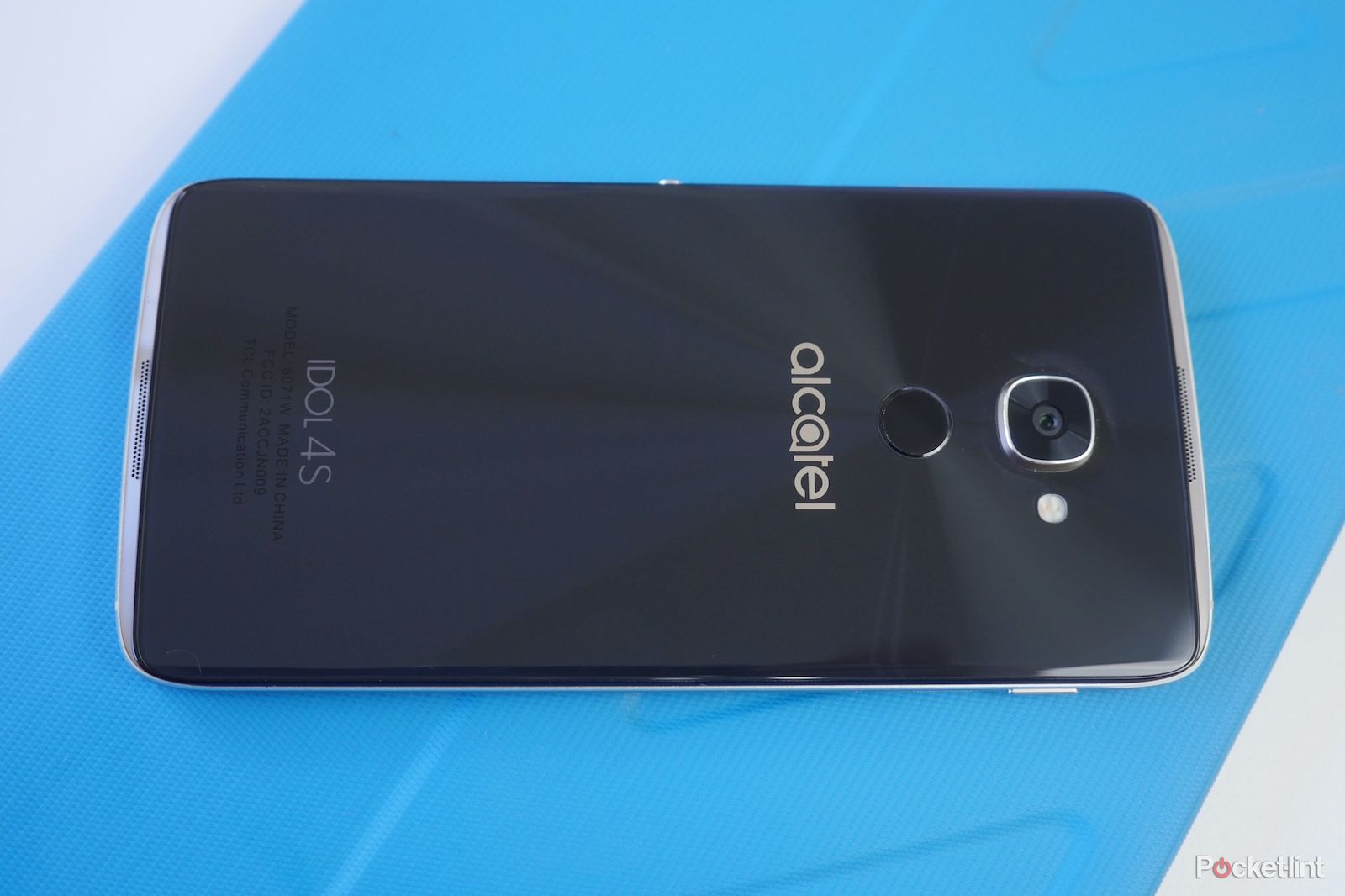
You can get a number of popular apps though. Facebook, Twitter, Netflix, BBC iPlayer and more are there for your choosing. But, like a lot of the other experiences, they load slowly or — in the case of iPlayer — don’t fit properly on the screen so that controls elements are missing, or part of the video is cut-off by the persistent on-screen buttons. That’s the Windows 10 experience on mobile: it just doesn’t have the development base and probably never will.
Despite the fact that there are now more official popular apps than there used to be, there are some glaring omissions like Snapchat, and some of them just don’t work well at all. Which leads us nicely on to…
Alcatel Idol 4S with Windows 10 review: Performance
- Snapdragon 820 processor
- Octa-core (4x 1.8 GHz & 4x 1.4 GHz)
- 4GB RAM, 64GB on-board storage
While the Idol 4S shares the same name as its Android-powered counterpart, the Windows 10 version this Alcatel phone has received a welcome specification bump. Rather than a middling Snapdragon 652 processor of Android, which has a tendency to stutter for some tasks, here there’s a Snapdragon 820 processor.
This is the same processor found inside devices like the OnePlus 3, Sony Xperia XZ and the Stateside versions of the Samsung Galaxy S7. Even Google’s latest Pixel phones have a slightly tweaked version called the Snapdragon 821.
In short, as far as mobile processors go, what’s inside the Idol 4S is one of the best available right now.
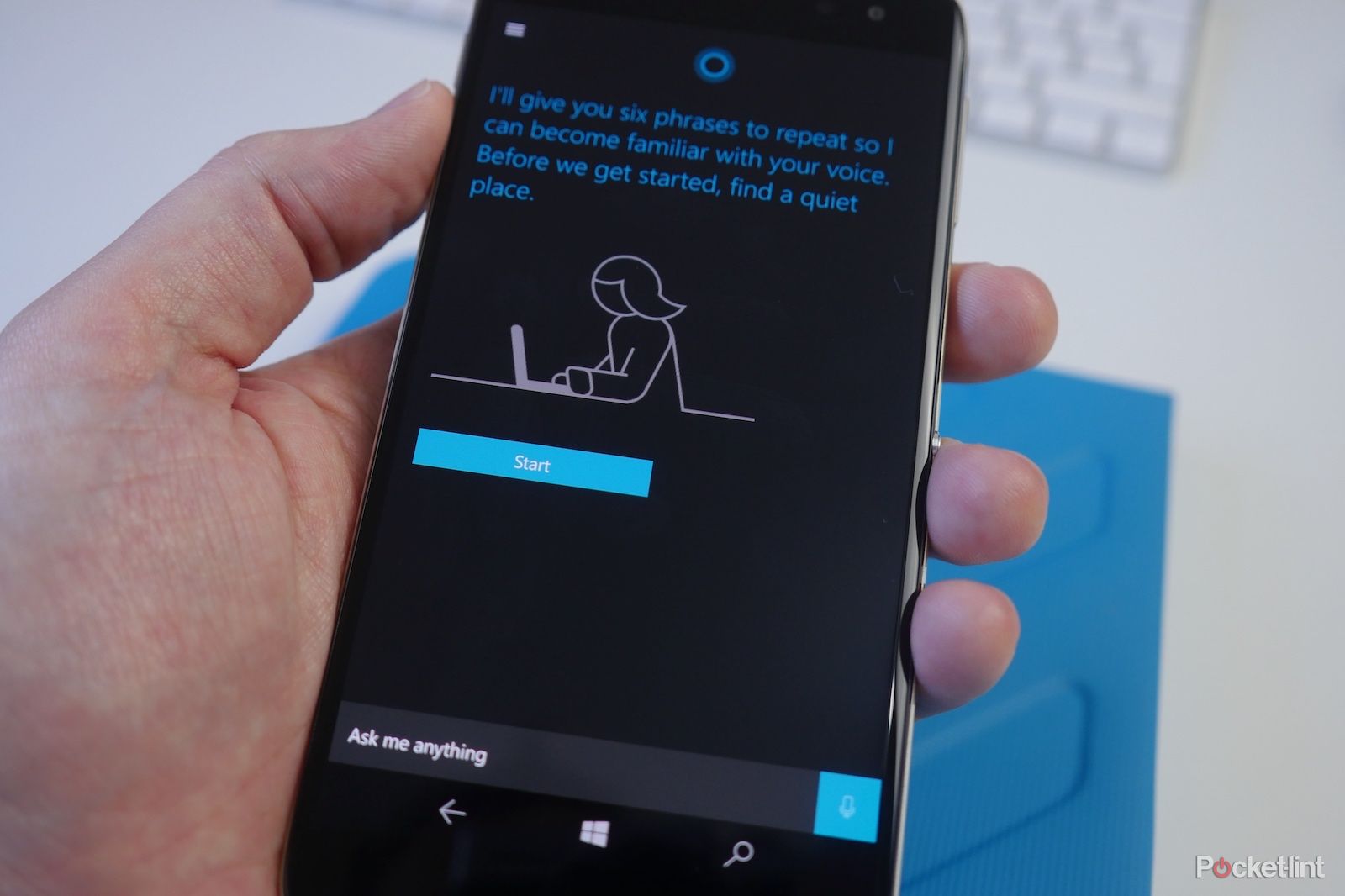
It was a surprise to us, then, that a lot of what we tested on the Idol 4S with Windows seemed slow. There wasn’t stuttering, frame-dropping or pausing as such, but so many actions took a couple of seconds — if not more — before kicking in to gear.
Using the fingerprint sensor on the back to unlock, for example, was noticeably slower than trying the same function on the Android-based (but physically identical) BlackBerry DTEK60. There’s no vibration feedback to let you know the fingerprint has registered on Windows 10 either — just a delayed unlocking of the phone a couple of seconds later.
Likewise, downloading apps from the Windows Store was a long process compared to both Android- and iOS-based phones of a similar flagship spec. Launching apps — especially third party ones — is laboriously slow. We lost count of the number of times we gave up on Facebook, after staring at the blue loading screen for at least 30 seconds. It’s 2016 people.
Other built-in functions and tasks are generally fine though. Launching the web browser, Cortana, Outlook and such didn’t provide any really noticeable delays (notice that they are all Microsoft products). Zipping in and out of the settings menu and app lists were smooth and snappy too. It’s just a shame that a phone with 4GB of RAM and a high-end processor doesn’t feel fast all the time.
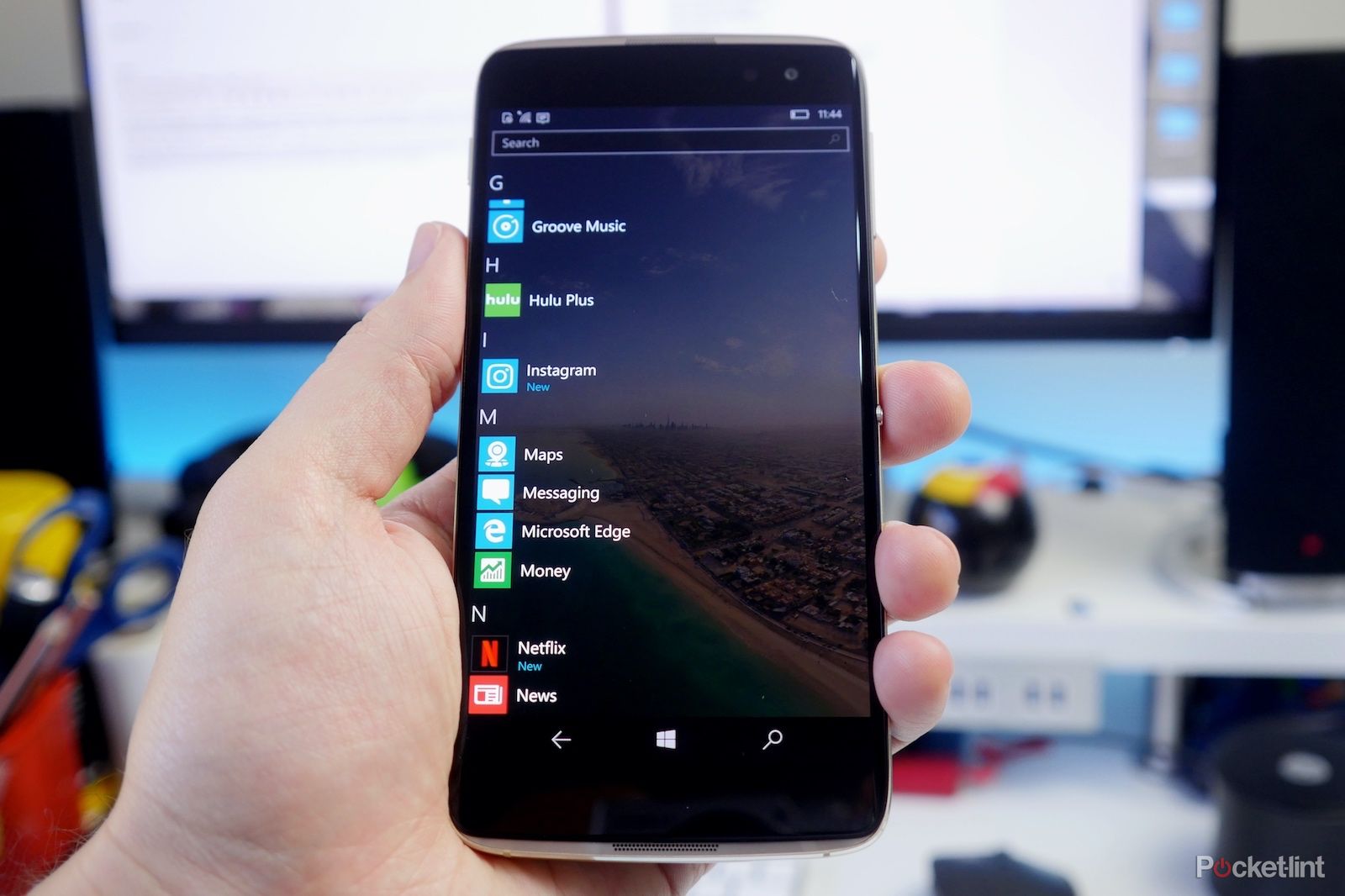
For the media hungry, you’ll be pleased to know the phone comes equipped with 64GB of storage space as well as microSD card support to expand that further.
Alcatel Idol 4S with Windows 10 review: Battery life
- 3,000mAh battery
- Quick Charge fast-charging
Inside, alongside all the other gadgetry, is a 3,000mAh battery — which is claimed to be capable of handling 20-hours of use. In real-world terms, that means you’ll have some battery left over at the end of a full day, but won’t get too far into a second day before needing to charge again.
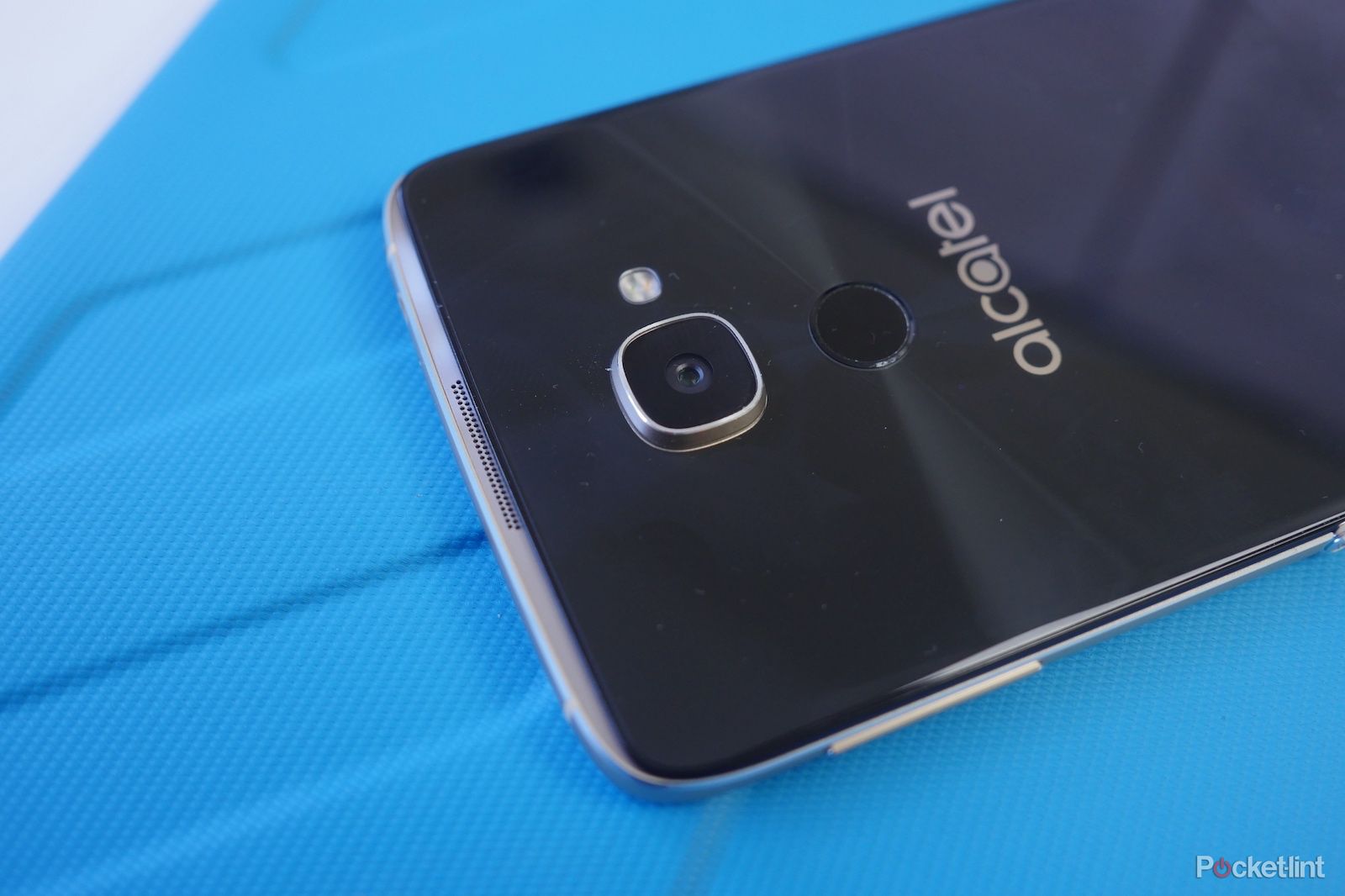
In our testing, the phone quite comfortably powered through a full day’s use with some juice left over. Indeed, even very heavy users should comfortably finish a work day with some battery remaining for the commute home with this Alcatel.
Not forgetting that the Idol 4S is also Quick Charge 3.0 enabled, so it’ll refill in a relatively snappy manner. Just 30-minutes at the plug can come in great use.
Alcatel Idol 4S with Windows 10 preview: Camera
The results from the Idol 4S are, unsurprisingly, similar to what we found with the newest BlackBerry DTEK60 phone: it can produce some decent, evenly balanced pictures with natural colour in good lighting conditions. When the light start to drop things get a bit ropey — as they do with so many other smartphone cameras.

However, like a lot of the Windows 10 experience, using the camera is a rather slow process with this device. Focusing on an object often took two or three tries, then when the shutter was pressed there was notable delay in response.
And because there’s no optical stabilisation (OIS) of any kind, if you move even slightly between pressing the shutter and the photo being taken, you’re left with a slightly soft and blurry image.
Alcatel Idol 4S
Amazon
To recap
There’s no doubting the hardware capability of the Idol 4S, we’ve seen it in work several times on Android. What’s disappointing here is the lack of optimisation from a software standpoint. With its slow loading, it can be quite an off-putting experience.
